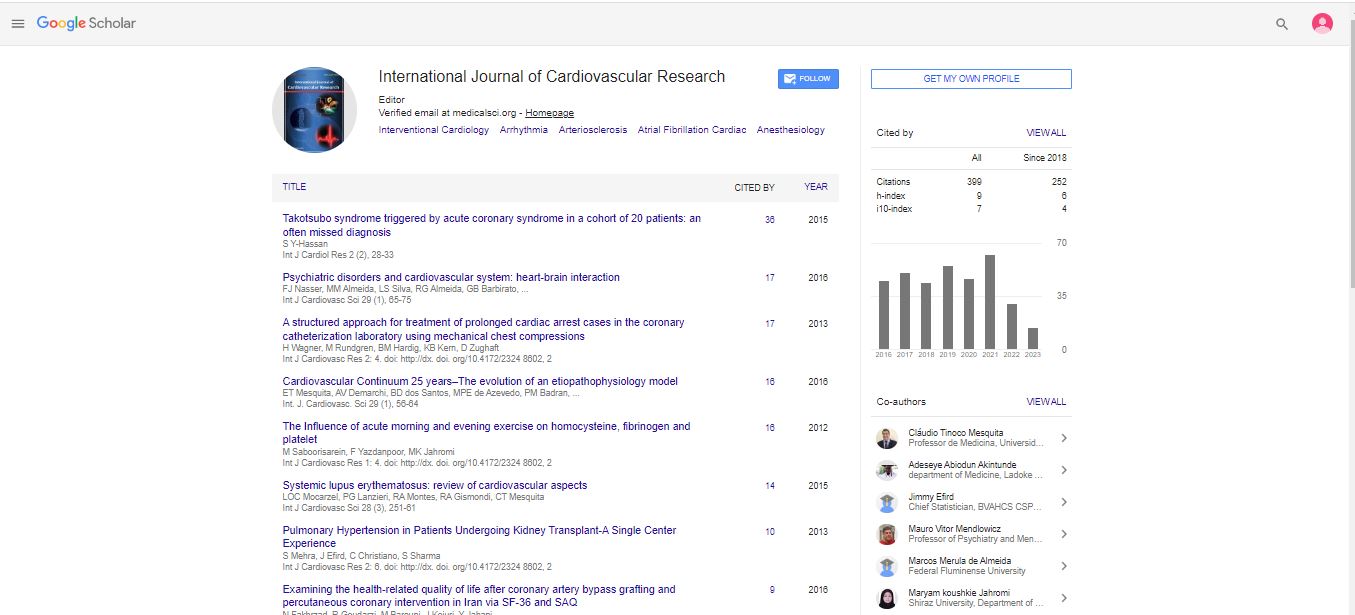The hypothesis of endovascular occlusion of the internal mammary arteries to treat patients suffering from refractory angina
Marco Piciche
San Bortolo Hospital, Italy
: Int J Cardiovas Res
Abstract
There is evidence that an ischemic stimulus may cause the internal mammary arteries (IMAs) to develop important collateral branches. In Leriche syndrome, the IMAs may be the main source of blood supply for the lower limbs. Communication is also possible between the IMAs and the native coronary arteries. This has been demonstrated by angiography in living patients. Postmortem angiography in patients with ischemic heart disease has demonstrated such connections in 12% of cadavers. The Vineberg operation of the 1940s was based on the plastic potential of the IMAs. It consisted of IMA implantation into the left ventricular wall. Another example of the IMAs’ potential for collateralization may be seen following imperfect coronary surgery, where blood flow is impeded by stenosis at the IMA-to-coronary artery anastomotic site, and eventually by graft occlusion in its middle-distal portion. In such a case new branches may arise from the IMAs and direct toward the heart within a few days, weeks or months of surgery. These observations suggest that IMAs exhibit a significant potential for plasticity that may be induced under hypoxic conditions and/or in the presence of an obstruction to anterograde flow. Before the advent of cardiopulmonary bypass, some authors believed that surgical ligation of the IMAs produced an increased blood supply to the myocardium through natural and pre-existing anastomotic channels. Currently, not all patients suffering from ischemic heart disease benefit from conventional myocardial revascularization techniques (no-option patients) and it is in this context that the concept of IMA occlusion has been promoted again since 2010. In man, transitory and mid-term angioplasty balloon ITA occlusion increases the collateral flow index and fractional flow reserve by means of a functional ischemia-reducing extra-cardiac coronary artery supply, via natural ipsilateral ITA bypasses. This new achievement reinforces the recent hypothesis that endovascular embolization/plug occlusion of the IMAs might be considered for otherwise untreatable patients. Recent Publications 1. M Picichè, J G Kingma, P Voisine, F Dagenais and E Fadel (2010) Angiogenesis and surgical or endovascular enhancement of noncoronary collateral circulation: a new research Field J Thorac Cardiovasc Surg 139:1675–1676. 2. M Stoller, S F de Marchi and C Seiler (2014). The function of natural internal mammary-tocoronary artery bypasses and its effect on myocardial ischemia, Circulation 129:2645–2652. 3. Stoller M and Seiler C (2017) Effect of permanent right internal mammary artery closure on coronary collateral function and myocardial ischemia Circ Cardiovasc Interv; 10 DOI: 10.1161/CIRCINTERVENTIONS.116.004990. 4. Picichè M (2016) Embolization of the internal thoracic arteries in refractory angina. International Journal of Cardiology 212:310 5. Picichè M (2017) Letter by Picichè Regarding Article, “Effect of permanent right internal mammary artery closure on coronary collateral function and myocardial ischemia” Circ Cardiovasc Interv; 10:e005777..
Biography
Marco Picichè completed his Graduation in Medicine from University of Florence in 1995 and Cardiac Surgery Residency at Tor Vergata University of Rome in 2000, both summa cum laude. He held regular teaching appointments at the University of Montpellier-School of Medicine; obtained certification by the French board in Cardiac Surgery (Paris, 2007); earned his Research Master’s in Surgical Science (Paris, 2007) and; received a University Diploma in Vascular Surgery (Paris, 2007). In Canada, he authored a research project on the occlusion of the internal mammary arteries as an alternative method of myocardial blood supply. In September 2011, he received PhD degree in Therapeutic Innovations from Paris-Sud University. He is the Editor in Chief of the book: “Dawn and Evolution of Cardiac Procedures: Research Avenues in Cardiac Surgery and Interventional Cardiology” (Springer-Verlag publishing house, September 2012). He patented a new surgical instrument. Currently, he is a Cardiac Surgeon in Italy.
 Spanish
Spanish  Chinese
Chinese  Russian
Russian  German
German  French
French  Japanese
Japanese  Portuguese
Portuguese  Hindi
Hindi 



